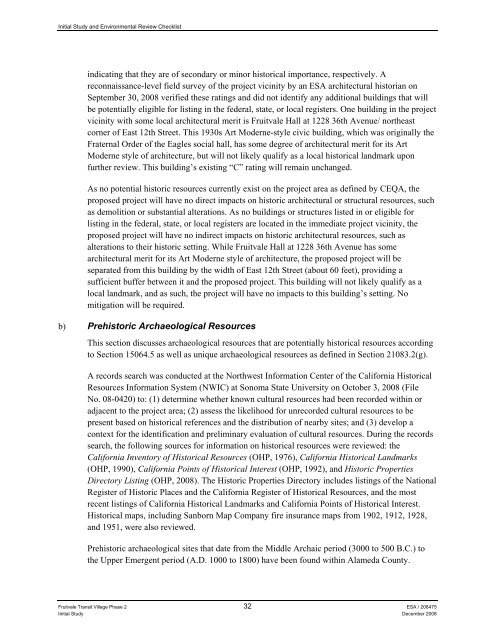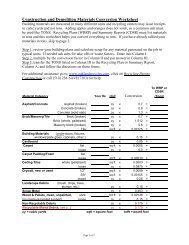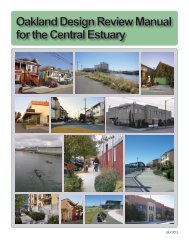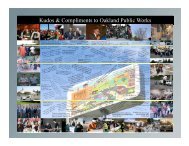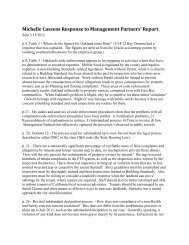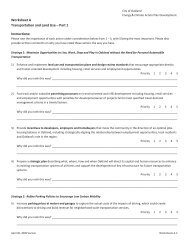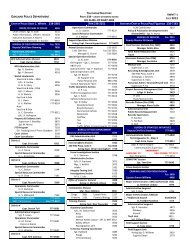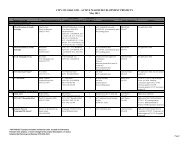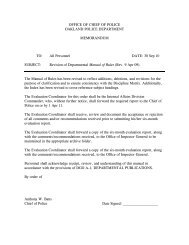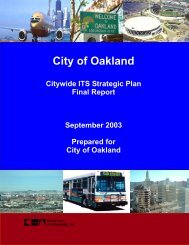Fruitvale Transit Village (Phase 2) Initial Study - City of Oakland
Fruitvale Transit Village (Phase 2) Initial Study - City of Oakland
Fruitvale Transit Village (Phase 2) Initial Study - City of Oakland
You also want an ePaper? Increase the reach of your titles
YUMPU automatically turns print PDFs into web optimized ePapers that Google loves.
<strong>Initial</strong> <strong>Study</strong> and Environmental Review Checklistindicating that they are <strong>of</strong> secondary or minor historical importance, respectively. Areconnaissance-level field survey <strong>of</strong> the project vicinity by an ESA architectural historian onSeptember 30, 2008 verified these ratings and did not identify any additional buildings that willbe potentially eligible for listing in the federal, state, or local registers. One building in the projectvicinity with some local architectural merit is <strong>Fruitvale</strong> Hall at 1228 36th Avenue/ northeastcorner <strong>of</strong> East 12th Street. This 1930s Art Moderne-style civic building, which was originally theFraternal Order <strong>of</strong> the Eagles social hall, has some degree <strong>of</strong> architectural merit for its ArtModerne style <strong>of</strong> architecture, but will not likely qualify as a local historical landmark uponfurther review. This building’s existing “C” rating will remain unchanged.As no potential historic resources currently exist on the project area as defined by CEQA, theproposed project will have no direct impacts on historic architectural or structural resources, suchas demolition or substantial alterations. As no buildings or structures listed in or eligible forlisting in the federal, state, or local registers are located in the immediate project vicinity, theproposed project will have no indirect impacts on historic architectural resources, such asalterations to their historic setting. While <strong>Fruitvale</strong> Hall at 1228 36th Avenue has somearchitectural merit for its Art Moderne style <strong>of</strong> architecture, the proposed project will beseparated from this building by the width <strong>of</strong> East 12th Street (about 60 feet), providing asufficient buffer between it and the proposed project. This building will not likely qualify as alocal landmark, and as such, the project will have no impacts to this building’s setting. Nomitigation will be required.b) Prehistoric Archaeological ResourcesThis section discusses archaeological resources that are potentially historical resources accordingto Section 15064.5 as well as unique archaeological resources as defined in Section 21083.2(g).A records search was conducted at the Northwest Information Center <strong>of</strong> the California HistoricalResources Information System (NWIC) at Sonoma State University on October 3, 2008 (FileNo. 08-0420) to: (1) determine whether known cultural resources had been recorded within oradjacent to the project area; (2) assess the likelihood for unrecorded cultural resources to bepresent based on historical references and the distribution <strong>of</strong> nearby sites; and (3) develop acontext for the identification and preliminary evaluation <strong>of</strong> cultural resources. During the recordssearch, the following sources for information on historical resources were reviewed: theCalifornia Inventory <strong>of</strong> Historical Resources (OHP, 1976), California Historical Landmarks(OHP, 1990), California Points <strong>of</strong> Historical Interest (OHP, 1992), and Historic PropertiesDirectory Listing (OHP, 2008). The Historic Properties Directory includes listings <strong>of</strong> the NationalRegister <strong>of</strong> Historic Places and the California Register <strong>of</strong> Historical Resources, and the mostrecent listings <strong>of</strong> California Historical Landmarks and California Points <strong>of</strong> Historical Interest.Historical maps, including Sanborn Map Company fire insurance maps from 1902, 1912, 1928,and 1951, were also reviewed.Prehistoric archaeological sites that date from the Middle Archaic period (3000 to 500 B.C.) tothe Upper Emergent period (A.D. 1000 to 1800) have been found within Alameda County.<strong>Fruitvale</strong> <strong>Transit</strong> <strong>Village</strong> <strong>Phase</strong> 2 32 ESA / 208475<strong>Initial</strong> <strong>Study</strong> December 2008


